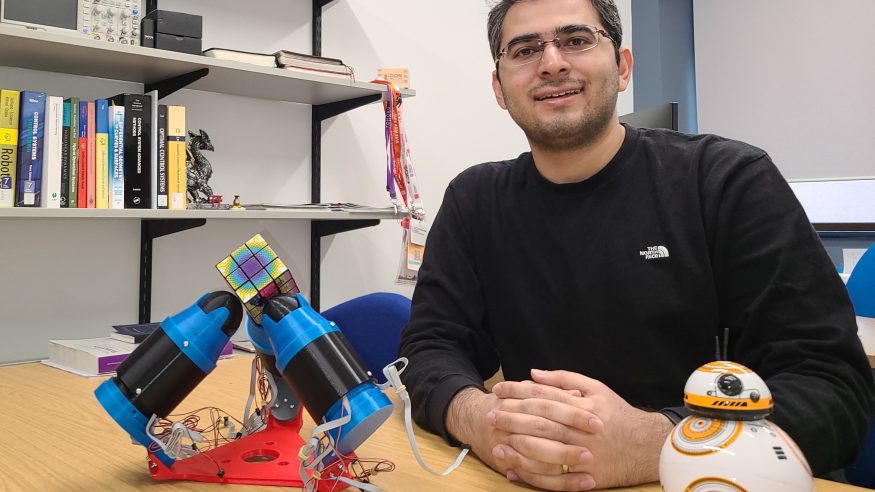Meet the Researcher – Dr Seyed Amir Tafrishi
18 October 2023
Dr Seyed Amir Tafrishi specialises in robotics and autonomous systems within the School of Engineering. We asked him a series of questions to find out more about the person behind the research and to find out how he is helping to make a difference to society:
1) What is your main area of research?
“I’m a roboticist, which means I dive into the world of robots! My main focus is on creating new kinds of robots by mixing cool control theory ideas. For instance, I’m working on making robots that can change their shapes! My research also spans different problems in robotics and control, from object manipulation, motion control of mobile robots and advanced robotic mechanisms for human assistance.”
2) Why did you become a researcher?
“Well, becoming a researcher was pretty much in the cards for me since I was a kid. I had this knack for asking ‘why’ and ‘how’ about everything around me. Toys didn’t stand a chance – most of them ended up in pieces as I tried to create something new out of them. My family might not have been thrilled with my ‘experiments,’ but they let me follow my curiosity.
“So, that spark of curiosity stuck with me as I grew up. I wasn’t always the sharpest tool in the shed, but that childlike wonder never left me. When I hit my third year of BSc studies, I really started to see my path. Robotics and control theory blew my mind – they were like these vast playgrounds of possibility.”
3) Is there any particular aspect of your research that you would like to highlight?
“I’ve ventured into various corners of research, but one thing that really fuels my excitement is digging into the world of mathematics and finding ways to make it play nice with real-world stuff. Take my PhD journey, for instance – I managed to build a bridge between geometric mechanics and robotics. Sounds fancy, right? Well, it’s all about crafting new strategies for robots to move in cool ways, and the best part is that these strategies actually work out in practice. Some of my works even made it into some prestigious math and robotics journals.
“There’s more! I’ve also been part of an interesting project backed by the Japanese Government called ‘Moonshot R & D.’ We prepared a concept involving multiple robots teaming up to provide human assistance and care. Imagine that – a squad of robots making life better!”
4) What are the next steps for your research projects?
“The path ahead is incredibly thrilling! Here at Cardiff University, I’m in the midst of something truly remarkable – the formation of the Geometric Mechanics and Mechatronics in Robotics (gm2R) team.
“Our mission? To delve deep into the development and control unconventional robotic systems. Picture robots that can contort, pivot, and execute tasks in ways that might astonish you. These ingenious marvels have the potential to redefine industries like manipulation, inspection, and even provide invaluable assistance to humans. Our strategy is to merge geometric principles with cutting-edge mechatronics to design extraordinary robots.
“We also engage in a collaborative effort with the Robotics and Autonomous Intelligent Machines (RAIM) group at Cardiff University, of which I am an academic member.”
5) Does your research have global impact?
“Absolutely, our research holds a global promise. It’s akin to planting seeds of innovation that are set to flourish on an international scale. Consider the UK’s ambitious net-zero vision – a future where autonomous, intelligent machines (or ‘robots’) are integral partners in performing tasks with unmatched efficiency. This vision is no longer confined to science fiction; it’s a concrete plan in motion.
“Also, advanced nations like the UK, Europe, and Japan are grappling with a distinct challenge. The availability of human resources, especially in crucial areas like caregiving and welfare, is dwindling. This is precisely where our research steps in. Envision robots extending a helping hand, adeptly handling objects, providing assistance, and even offering care to individuals. It’s a fusion of technology and compassion poised to sculpt a brighter tomorrow. So, you could rightly say that our work transcends local boundaries, with the potential to impact lives globally.”
6) Do you have any advice for future students considering becoming an academic/researcher?
“Diving into research is a commitment, no doubt about it. But let me tell you, the feeling of contributing to the scientific community is something truly special. Picture this: knowing that your work is shaping the future, changing lives, and expanding the boundaries of human knowledge – it’s like one of life’s biggest high-five.
“Here’s my personal nugget of wisdom. Don’t ever be afraid to chase after what sets your heart on fire, whether it’s research or any other career path. But, here’s the twist – be ready to stumble along the way. Especially in the world of research, failure is kind of a regular guest at the table. You’ll fail, forget how many times you’ve failed, and then fail some more. But don’t let that deter you.
“In fact, we’re in a time where being the ‘smartest’ isn’t the only ticket to success. The real deal is being curious, constantly questioning things, and not giving up – that’s the secret sauce.”